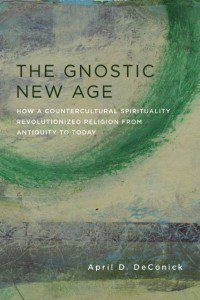Over the past few years, I have written three posts inspired by the scholarship of Jeffrey Kripal:
- Mystical Humanism – on the intersection of the scientific method with more-subjective firsthand spiritual experiences.
- Eve Was Framed, the Serpent Was Right! Gnostic Reflections on Religion
- Reflexive Re-Readings of Religion – connected to a class on “Comparing Religions: Coming to Terms.”
Kripal is a religion professor at Rice University in Houston, and one of my favorite contemporary religion scholars.
 I am bringing up Kripal today because he shares some areas of research with his colleague April DeConick, Chair of the Religion Department at Rice. And today’s post is inspired by DeConick’s new book on The Gnostic New Age: How a Countercultural Spirituality Revolutionized Religion from Antiquity to Today. I would like to invite you to consider some of the important connections between ancient Gnosticism and the “Spiritual But Not Religious” phenomenon today.
I am bringing up Kripal today because he shares some areas of research with his colleague April DeConick, Chair of the Religion Department at Rice. And today’s post is inspired by DeConick’s new book on The Gnostic New Age: How a Countercultural Spirituality Revolutionized Religion from Antiquity to Today. I would like to invite you to consider some of the important connections between ancient Gnosticism and the “Spiritual But Not Religious” phenomenon today.
To share some of DeConick’s story, in 1982 she entered college with plans to be a nurse. But that same year, her mother handed her a book she had just finished reading, saying, “I bet you will like this.” It was a new book that had just been published, titled The Other Gospels. It was described as, “Gospels that never made it into the New Testament. Unknown saying of Jesus.” Her mother was right: DeConick was intrigued (1).
She was particularly struck by the third verse of The Gospel of Thomas, which she had never heard of previously, in which Jesus says:
The kingdom is inside of you, and it is outside of you. When you come to know yourself, then you will become known, and you will realize that it is you who are the sons of the living father. But if you will not know yourself you dwell in poverty and it is you who are that poverty. (20, my emphasis)
DeConick wanted to know about this perspective on religion and spirituality, which taught “Know yourself” and “Seek the divine within yourself—or risk living an impoverished life” (1).
In her quest to learn more, she next found Elaine Pagels’s book The Gnostic Gospels, which had been published three years earlier in 1979. Pagels was one of the first scholars to write a book that was scholarly, accessible, and popular about the Gnostic manuscripts, which had been discovered in 1945 near Nag Hammadi, Egypt. Soon afterward, DeConick found James Robinson’s 1977 book The Nag Hammadi Library in English, which was a primary source translation of the texts themselves (2).
For the almost two thousand years of Christian history, most Christians only had access to orthodox writings against Gnosticism. Suddenly in 1945 we were able to read what the Gnostics had to say about themselves. And scholars have increasingly come to see that there was not a simple, direct, unbroken line of succession from Jesus of Nazareth to Peter as the first pope straight through until Pope Francis today. According to that traditional view, any alternative perspective was a heretical deviation from the one, correct, orthodox way. The truth turns out to be much messier and more complex than that. The orthodox perspective was merely one among many groups competing against one another to be considered a legitimate extension of the Jesus movement (3). (I’m tempted to go into more detail here, but I have blogged about this previously in a post titled, Lost Christianities and Banned Books of the Bible.)
For now, I will say just a little more to emphasize the huge shift that comes from reading what a group says about itself in comparison to what its opponents say about them. Consider, for example, if the only access you had to the outside world was Fox News. That’s essentially the situation we were in prior to the 1945 discovery of Gnostic texts near Nag Hammadi: we only had the Fox News version of Gnosticism.
As a college freshman in 1982, when DeConick was first reading these newly-released, paradigm-shifting books about Gnosticismshe began to realize that as valuable as these early interpretations of Gnosticism were, she was not convinced they were fully reading the Gnostics correctly. Some of the previous biases about Gnosticsm seemed to be skewing the interpretations of these new texts. In particular, the Gnostics were consistently described as unorganized and anti-ritual, but as she read the Gnostic texts closely for herself, the opposite seemed to be the case. The Gnostic texts explicitly described rituals for cultivating “intense religious experiences of spiritual transformation…. And they were doing so in organized groups with guru-type leaders.” This realization was a turning point for DeConick that lead her on a decades-long study of Gnosticism which included earning a Ph.D. in Near Eastern studies at the University of Michigan (3).
As it turns out, long before Marx was condemning religion as the “opiate of the masses,” the Gnostics were questioning the ways that much of conventional religion supported the status quo. In contrast, Gnostic approaches to spirituality were about transcending conventional conceptions through ritualized, firsthand spiritual experiences of union with the Sacred, the Holy, the numinous—beyond ideas about “God” (4). Consider the difference between writing about apples and actually taking your first bite of an apple—and thus coming to know an apple, not intellectually, but existentially.
Part of DeConick’s contribution to contemporary scholarship to invite us to consider Gnosticism as more than a one among many early Christian sects. Instead, it is more of a “countercultural orientation”—an approach to spirituality that could potentially be present in almost any religious movement (4-5). Gnosticism (from the Greek “to know”) derives its name from the special “knowledge” about reality attained through firsthand religious experiences. Our silent “k” in knowledge is due to the silent “g” in gnostic.
To cultivate a state of ecstasy, the rituals were often extensive and highly participatory. To give you just one example, one Gnostic initiation ritual involved an individual going through a total of twenty-two baptisms (225). Compared to a single individual public Sunday morning baptism, consider the impact of an all-night private ritual of chanting, increased sleep deprivation, and immersion after immersion in water.
Gnostics claimed to have discovered in their own firsthand experience a much more powerful, unifying spirituality beyond the “God” described in the Bible. And many orthodox Christian leaders perceived these claims as a threat. They were terrified of people questioning religious hierarchy based on their own firsthand experience. And to give just one example of the anti-Gnostic polemics, in the late second century, an early orthodox Christian bishop named Irenaus wrote a five-volume series of books titled Against the Heresies (54).
To be clear, the Gnostics were literally heretics. The word heretic comes from the Greek αἵρεσις, meaning “choice.” Rather than unquestioningly accepting the secondhand teachings of tradition, they chose for themselves what to believe, based on their own firsthand experience. In that spirit, Unitarian Universalism is sometimes called a “chosen faith.”
In the ancient world, part of why the Gnostics were so threatening to orthodoxy is that they used the Hebrew and Christian Scriptures to bolster their own claims. They pointed to passages such as Genesis 3 where God is described as “walking” through the Garden of Eden and “calling” for Adam and Eve, who are hiding. The Gnostic asked: what kind of God walks around like a human? And what kind of God are humans able to hide from? For the Gnostics, these—and many other similar passages from the Bible—were evidence that the God of the Bible was, at most, a lesser god—distinct from the “Ground of All Being” they had experienced (91). They pointed to all the times that the God of the Bible is capricious, petty, jealous, even genocidal at points—credited with killing large numbers of people for various different reasons (93).
Whereas the biblical God punished Adam and Eve for eating from the “Tree of the Knowledge of Good and Evil,” the Gnostics saw this transgressive act as the means of salvation. They admired the serpent, who tells Eve in Genesis 3 that if she eats of the fruit, “You will not die…. Your eyes will be opened, and you will be like God” (55). Indeed, some of the Gnostics are known as Sethians—because they identified with Adam and Eve’s third son Seth, after Cain and Abel. Seth “is the only early character in the Bible who never interacts with or worships YHWH” (97).
(I will continue this theme tomorrow in a post on “How to Move from Secondhand Theology to Firsthand Spiritual Experience.”)
The Rev. Dr. Carl Gregg is a certified spiritual director, a D.Min. graduate of San Francisco Theological Seminary, and the minister of the Unitarian Universalist Congregation of Frederick, Maryland. Follow him on Facebook (facebook.com/carlgregg) and Twitter (@carlgregg).
Learn more about Unitarian Universalism: http://www.uua.org/beliefs/principles
















